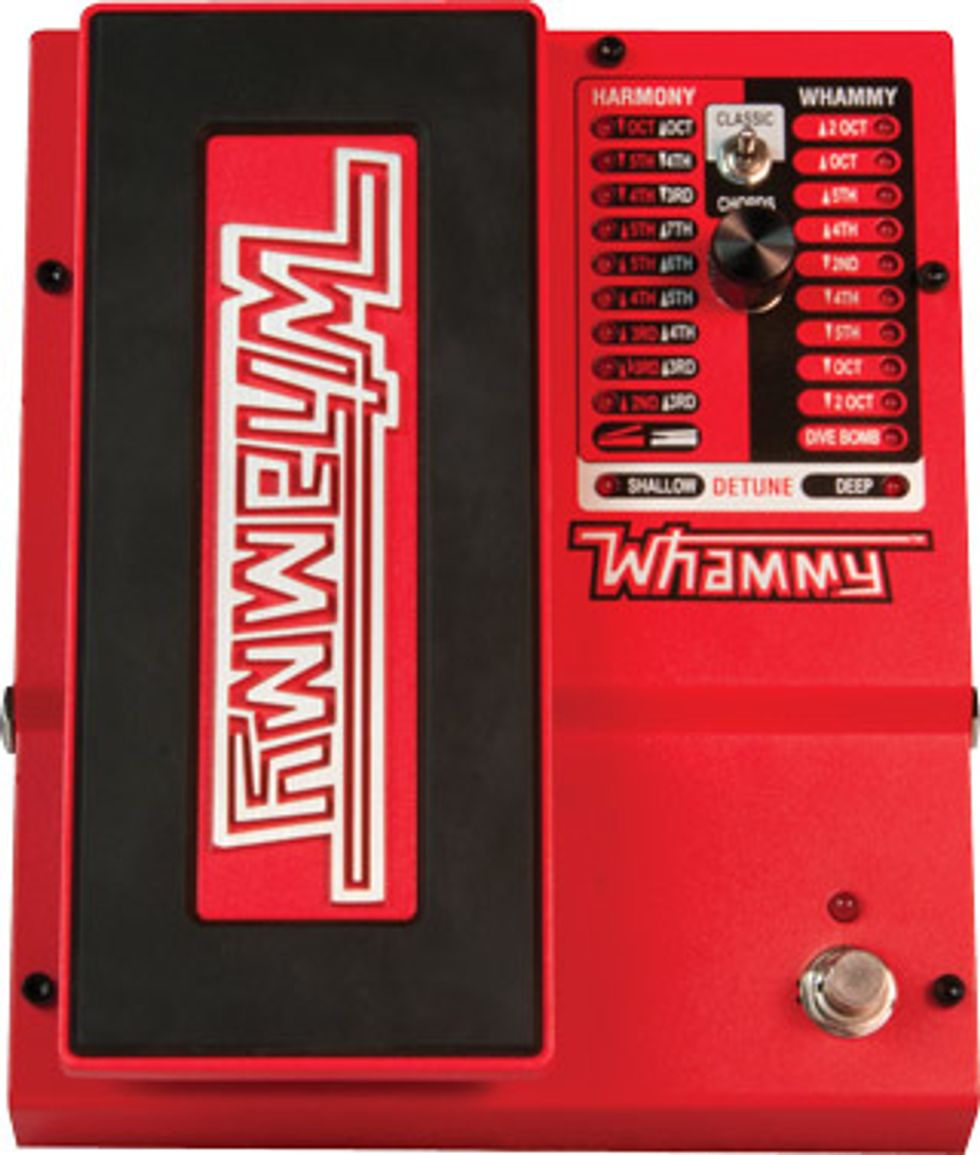
There are few pedals as iconic—and instantly recognizable—as the DigiTech Whammy. Many players originally cast it aside as a novelty effect, but the pedal found its purpose and realized its potential with a new breed of guitarists in the mid and late ’90s that recognized its expressive pitch-shifting capabilities as an avenue for sculpting new, otherworldly tones.
The pedal has gone through several revisions and build changes since its inception, but real pitch-shift connoisseurs still turn their gaze back to the pedal that started it all, the coveted and highly regarded WH-1. And the fifth-generation Whammy reviewed here gets ever so close to the original’s famed sound, while packing in some much-needed modern updates.
Wham Bam, Thank
You, Ma’am
With a depth of 7 3/4" and
length of 6 1/2", the newest
issue of the Whammy is
closer in terms of look and
size to the original than the
fourth-generation model.
This might not seem like
something worth mentioning,
but if you’ve ever played an
original Whammy, it’s kind of
a big deal. They were pretty
small pedals, which gave them
a very different—some say
more immediate—feel beneath
the player’s foot. Under the
hood, the pedal’s pitch-shifting
algorithms have been updated
for smoother response. The
update also includes true-bypass
switching and 9V DC
power-supply operation so
the pedal can finally run off
of the power bricks on most
pedalboards without a special
adapter. There are also four
additional Whammy modes
taken from the Whammy DT
pedal. And a polyphonic pitch-shifting
mode has been added
too, just in case you don’t like
the Whammy’s chaotic, glitchy
reaction when playing chords
(don’t fret noisemakers, you
can switch between the two).
The Whammy IV’s drop-tune
mode has been scrapped, along
with the dedicated dry-output
jack, though you can achieve
the same effect using the new,
2nd DN mode.
Ratings
Pros:
Smooth-as-silk pitch shifting. Long-overdue
true-bypass switching.
Cons:
Quick riffing in its polyphonic mode can
cause the pedal to glitch ever so slightly at times.
Tones:
Ease of Use:
Build:
Value:
Street:
$199
DigiTech
digitech.com
Pitch Perfect
Many—including DigiTech
themselves—have tried for
years to capture the same
magic of the first Whammy.
And doubtless, many will find
that the Whammy V gets the
closest. Employing a Les Paul
Custom and a Mesa/Boogie
Dual Rectifier, there was a
perceptible improvement in the
smoothness of the pedal’s pitch
bending as I moved up and
down through the octave-up
mode. There were no hiccups
anywhere in the sweep. And
as I moved down the neck
to try and confuse the pedal
and upset the tracking with
low, guttural notes, the effect
remained slick and very precise.
The harmony modes are excellent, and offer up a smorgasbord of wild, dual-guitar lead possibilities, thickened single-note drones, and oddball, dissonant textures. Creative possibilities aside, you can still hear digital artifacts in the harmony mode. When I would play a melody and shift up or down, then move to where the previous notes had been shifted, there was a slight, digital sheen to the attack. You don’t lose all the warmth though, and I don’t recall using a Whammy that was this natural and smooth sounding since the years I owned an original Whammy II.
In the polyphonic mode, the pedal handles simple and complex chords with ease. Throwing a 9th chord or tritone in the mix can induce a little glitching for just a fraction of a second, but generally only when playing fast rhythms. DigiTech also made a wise decision by adding the Whammy DT’s 5th and 4th interval-up, and 2nd, 4th, and 5th interval-down modes to the pitch-shift menu, and they yield some seriously sick tones when you slowly shift one chord down or up to another.
The Verdict
Through five design iterations,
the Whammy has added
new dimensions and textures
to countless songs. And for
all intents and purposes, the
Whammy V is one of the best
Whammys to bear the name.
With the addition of true
bypass, a slightly smaller and
more comfortable footprint,
and tighter shifting programming,
it’s a real winner—and
still one of the most fun and
interesting pedals you can add
to your arsenal.











![Rig Rundown: Russian Circles’ Mike Sullivan [2025]](https://www.premierguitar.com/media-library/youtube.jpg?id=62303631&width=1245&height=700&quality=70&coordinates=0%2C0%2C0%2C0)









